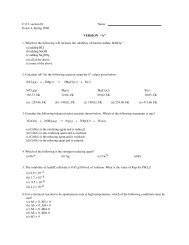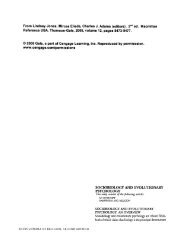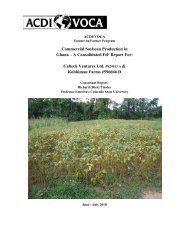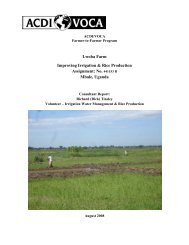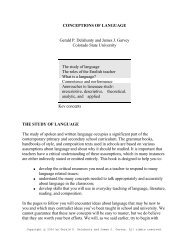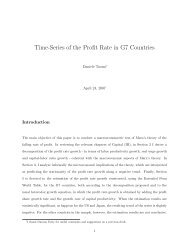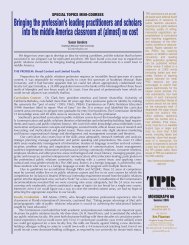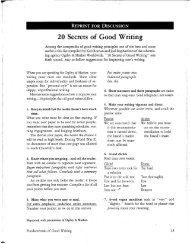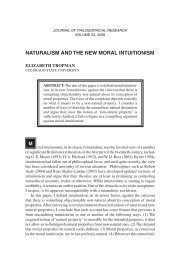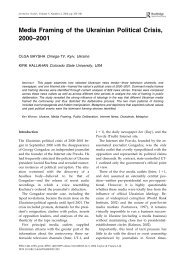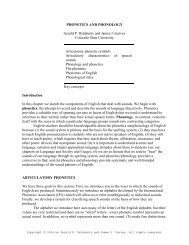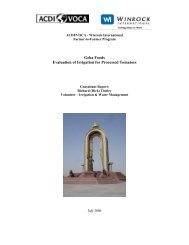Trail Log 1995-1997 - Lamar at Colorado State University
Trail Log 1995-1997 - Lamar at Colorado State University
Trail Log 1995-1997 - Lamar at Colorado State University
You also want an ePaper? Increase the reach of your titles
YUMPU automatically turns print PDFs into web optimized ePapers that Google loves.
Drove home in the dark. Kentucky fried chicken halfway back home.<br />
Penguins are found only in the Southern Hemisphere.<br />
July 28, Sunday. Drove southwest to Geelong (pronounced juhlong), then Torquay, and the Gre<strong>at</strong><br />
Ocean Road. Kangaroos on a golf course <strong>at</strong> Anglesea. About 50 seen, all sizes, said to be<br />
kangaroos and mostly females and joeys.<br />
Lunch <strong>at</strong> Lorne in a scenic picnic area.. Cloudy bright <strong>at</strong> best, often overcast. On to Apollo Bay,<br />
got motel about 2.00 p.m. It is quite scenic between Lorne and Apollo Bay, a seaside drive.<br />
Continued west. Some nice Eucalyptus forests here.<br />
Near Princeton, black swans, 8 of them. W<strong>at</strong>ched them some while, the first I have seen. Dusky<br />
moorhen on pond.<br />
Reached the Twelve Apostles. Some eight seen from one loc<strong>at</strong>ion.<br />
Loch Ard Gorge. A ship wrecked here in 1878, 52 people died, 2 survived. A narrow gorge carved<br />
in by the sea. This is the Shipwreck Coast. The Island Archway (took picture). Muttonbird Island<br />
(short-tailed shearw<strong>at</strong>er). This bird flies to the Aleutian Islands up by Japan and down the<br />
California coast, 30,000 km, up to 600 km per day.<br />
I walked in to the Blowhole, 100 meters inland and yet the sea has carved out an underground<br />
tunnel this far in.<br />
July 29, Monday. Drove back to Melbourne. Overcast day. Leisurely drive, little traffic on the road.<br />
Looked <strong>at</strong> juvenile Eucalyptus leaves.<br />
Stopped <strong>at</strong> Anglesea golf course again. Took pictures of kangaroos. Bought American hot dogs<br />
for lunch.<br />
Jane did a woolen museum tour in Geelong.<br />
Rain<br />
Eucalyptus - sheds its bark once a year, r<strong>at</strong>her than its leaves! Nearly 90% of Australia's plants are<br />
found nowhere else in the world (endemics). Most plant families have members with rel<strong>at</strong>ively<br />
small, rigid or hard leaves, schlerophylls, adapted to dry conditions and poor soil. There are layers<br />
of hard cells bene<strong>at</strong>h the leaf surfaces th<strong>at</strong> keep them rigid. Or they have long, narrow leaves. Or<br />
no leaves, reduced to scales along a green stem.<br />
She-oak. The wood is like oak -- hard, dense, straight grained, but not as good a real oak (he-man<br />
oak!), a weaker oak. But others doubted this etymology.<br />
Eu-calyptus. Eu-calyptra, a true cap. The flower buds of all species have an operculum (cap). The<br />
world's tallest hardwood is a eucalypt in Tasmania, nearly 100 meters tall, the length of a football<br />
field.<br />
Grass trees. Xanthorrhoea, a distant rel<strong>at</strong>ive of lilies. Among the slowest growing plants in the<br />
world, it puts out only one new circle of leaves each year. They go back 100 million years.<br />
Australian farmers lose 4 kg. of soil to produce a loaf of bread. The soils are old, and from altern<strong>at</strong>e



